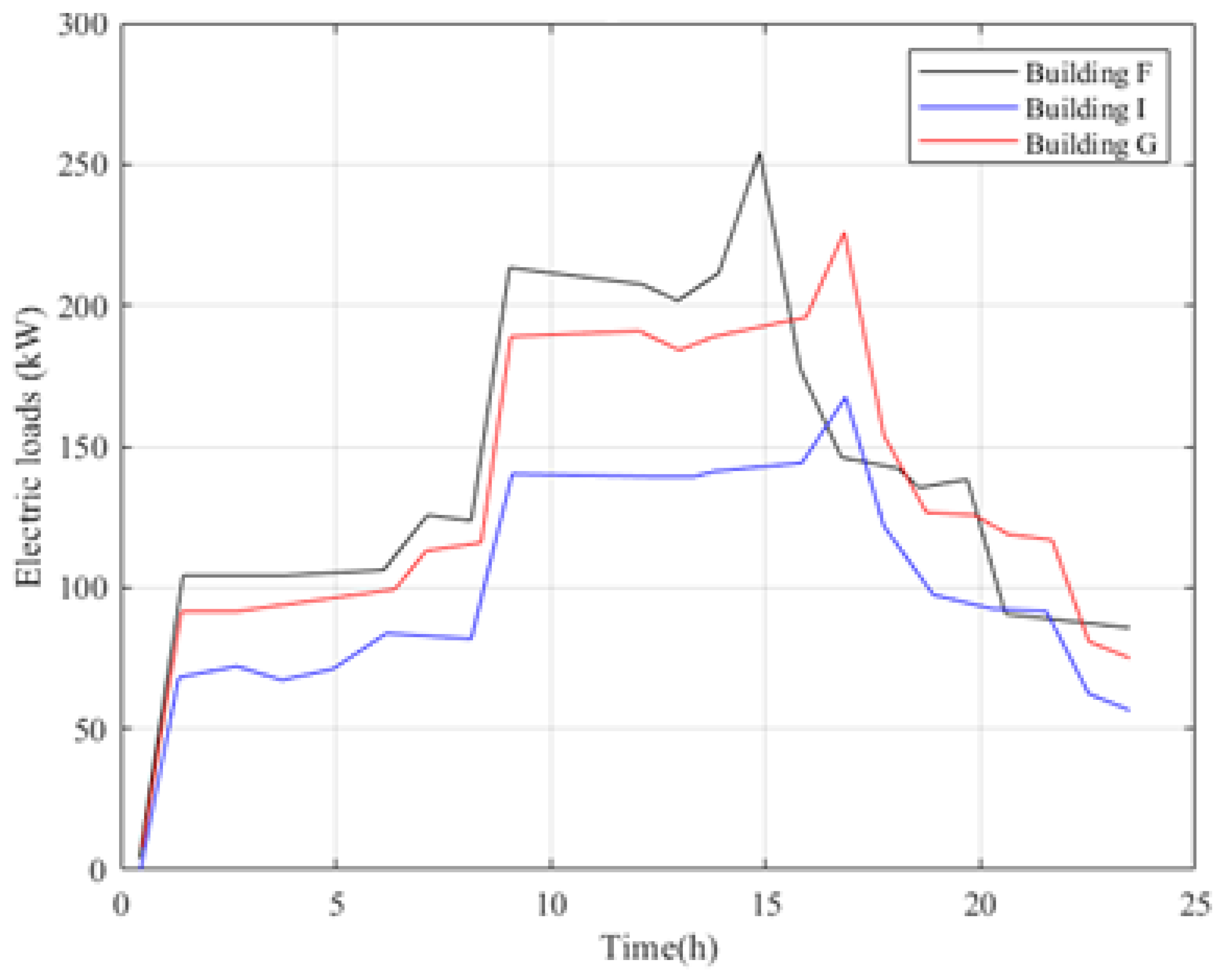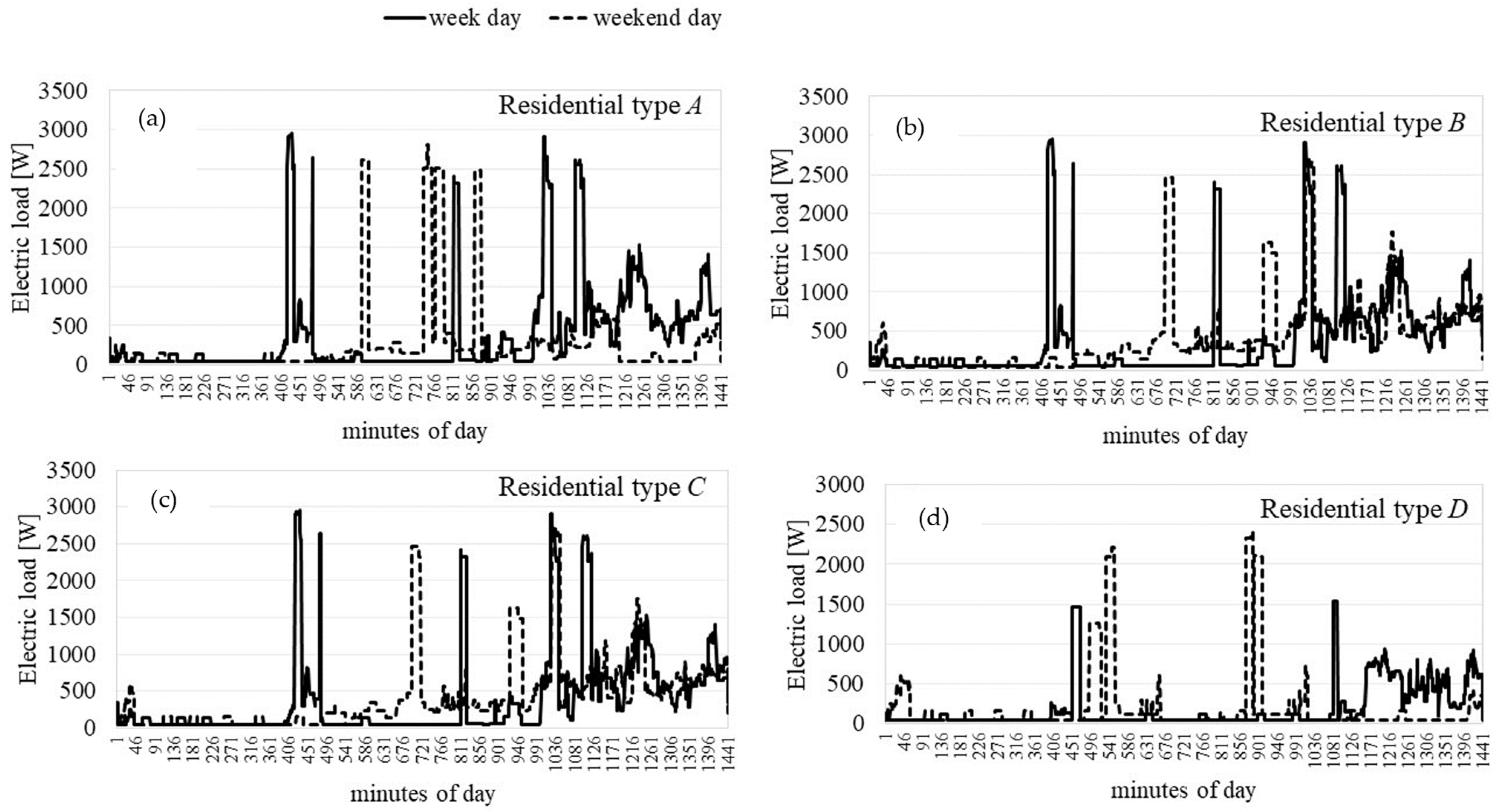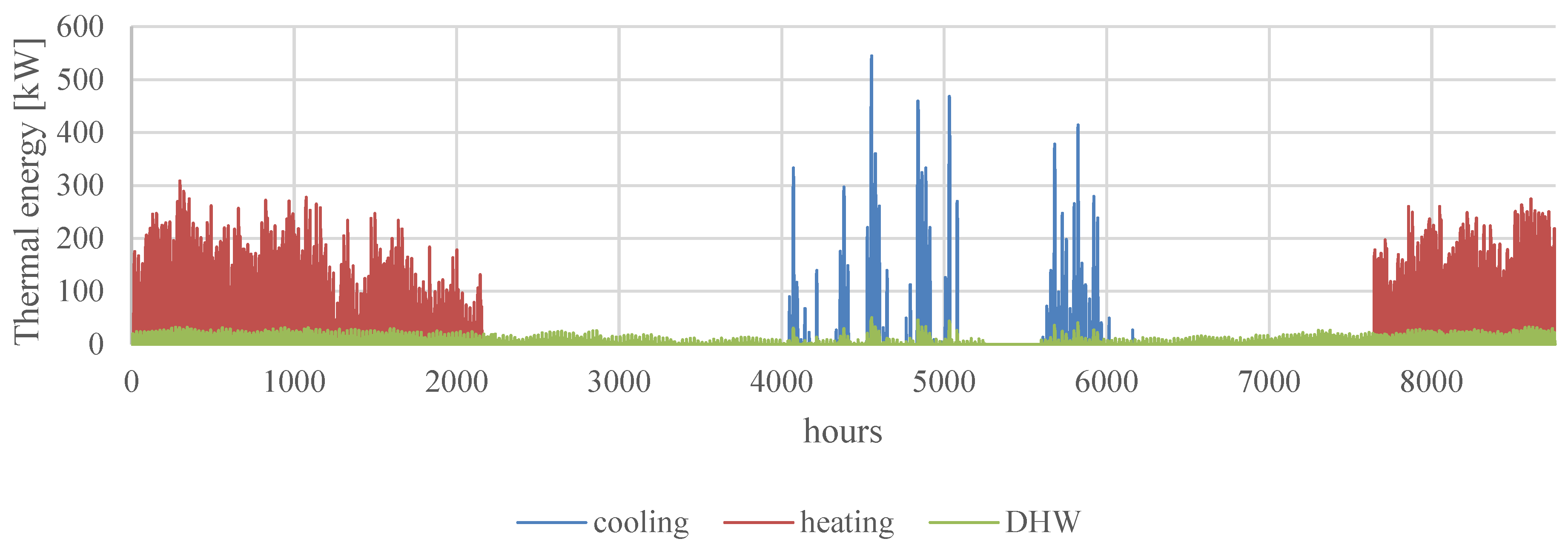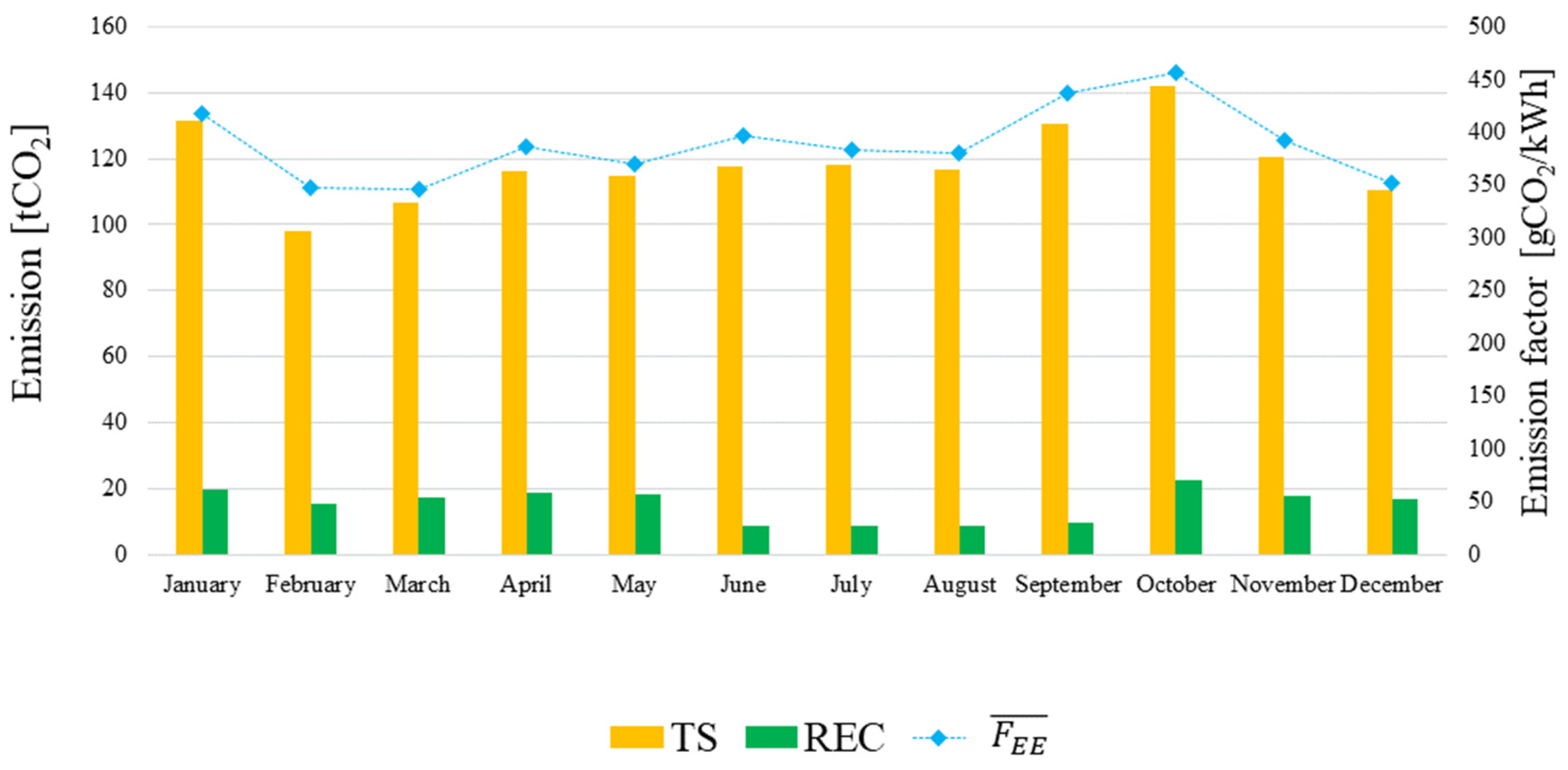Empowering Energy Communities through Geothermal Systems
Abstract
1. Introduction
- The definition of a community based on thermal (cooling/heating and domestic hot water) and electric sharing composed of different user sectors;
- The use of economic analysis according to REDII and its Italian transposition for an electric and thermal REC;
- The modelling of existing buildings using real data from audit and simulations in order to characterise the energy loads of REC;
- The use of real data related to the geothermal wells;
- The energy index definition used to evaluate the benefits of a geothermal-based community.
2. Methods
2.1. Buildings’ Energy Model
- User 1: 2 working adults, 2 children of school age;
- User 2: 2 working adults, 1 child of school age, 1 elderly person;
- User 3: 2 retired elderly people;
- User 4: 2 working adults.
- The dynamic hourly demand of residential buildings has been evaluated with the EdilClima v.6 software that uses the dynamic approach of the standard UNI EN ISO 52016-1 [34]. It includes simplified hourly dynamic calculation methods for assessing energy needs for heating and cooling, internal temperatures, and other relevant thermal parameters. At the beginning of the simulation the initial indoor temperature is equal to 20 °C. Weather-related parameters are chosen from an archive of hourly climatic data, including the hourly values of outdoor temperature, direct and diffuse solar irradiance, outdoor relative humidity, vapour pressure, and average wind speed (“Typical years” provided by Italian Technical Committee). Internal Heat Gains, such as occupants, lighting, appliances, and equipment, are assumed considering the standard ISO18523-1 [35]. Thermal Properties of the Building are chosen according to the Italian Minister’s Decreed ‘Minimal Requirements’ for new buildings. The method requires that the element class and the total thermal capacity of the structure, expressed in kJ/m2K, are defined for each opaque building component. Each element of the building envelope (opaque or transparent component) is discretised in a number of parallel layers separated by internal, external, and internal nodes from the building element. This method is detailed in Equations (1)–(5).
- -
- To accurately assess the thermal loads of office buildings for both heating and cooling, a detailed simulation was conducted in the TRNBuild 18 environment through the multizone building model. This component model deals with the thermal balances of a building. The building model in Type 56 is a non-geometrical balance model with one air node per zone, representing the thermal capacity of the zone air volume and capacities that are closely connected, like furniture, with the air node. The existing transfer function method of the building model TYPE 56 for walls can be used for solving the one-dimensional heat conduction problem. The Transfer Function Method (TFM) in TRNSYS’s building model TYPE 56 is essential for simulating the thermal behaviour of buildings. TFM dynamically calculates heat transfer in buildings, modelling the response to indoor and outdoor temperature variations. It represents indoor temperature and heat flux as functions of past outdoor conditions and internal heat gains. TFM balances computational efficiency with accuracy by simplifying heat transfer into linear equations, making it suitable for detailed energy analysis. The boundary (like external weather, adjacent structures, ground conditions, and internal loads) and initial conditions (such as starting temperatures, HVAC system status, and moisture content) are defined by the user. The occupancy schedule of office rooms covers a range of 1–10 person from 7 a.m. to 8 p.m. In line with Italian regulations and the climatic region encompassing Naples, the heating period spans from 15 November to 31 March [36], while the cooling season is selected between 1 June and 30 September. The periods between these seasons (1 April–31 May and 1 October–14 November) do not demand space heating or cooling.
2.2. Environmental Analysis
2.3. Socio-Economic Plan Analysis for Electric Sharing
- -
- OCEl represents the operating cost associated with yearly electricity demand;
- -
- CO&M includes the maintenance and management costs of plants, including the software for REC management and two employed persons for technical staff. This parameter is null under TS conditions.
3. Case Study
3.1. Geothermal Area
3.2. Building and User Description
3.3. System Configuration and Components
4. Results
4.1. Energy Results
4.2. Environmental Results
4.3. Economic Results
- For the first case (C#1), and are fixed to 0.30 €/kWh by considering the electricity price from 2021, before the energetic conflict involving Ukraine and Russia, and 53.40 €/MWh, which corresponds to the minimum price at which the geothermal plant’s energy can be sold to the PG [47].
- For the second case (C#2), and are fixed to 0.39 €/kWh by considering an increment of 30% of unit electricity price after the energetic conflict and to 69.42 €/MWh, which corresponds to an increment of 30% with respect to the minimum price for geothermal energy to sell to the PG.
- For the third case (C#3), and are fixed to 0.48 €/kWh by considering an increment of 60% of unit electricity price after the energetic conflict and to 111.07 €/MWh, which corresponds to an increment of 60% with respect to the minimum price for geothermal energy sell to the PG.
| Symbol | Description | Unit | Value (C#1/C#2/C#3) |
|---|---|---|---|
| Unit price for electricity taken from PG | €/kWh | 0.30/0.39/0.48 | |
| Economic incentive for self-consumption REC | €/MWh | 118 | |
| Unit price for electricity sell to PG | €/MWh | 53.4/69.4/111 | |
| Economic cost for two workers on REC staff | k€/y | 64 | |
| Economic cost of ORC maintenance calculated as 5% of investment cost | k€/y | 75 | |
| Economic cost for management software for RECs | k€/y | 13 | |
| Operating cost for electricity for residential user | €/y | 1424 * | |
| Income for residential user | k€/y | 12 | |
| ZORC | Investment cost for ORC | k€ | 1500 |
| Zwells | Well investment cost | k€ | 130 |
| Zpumps | Hydronic pump investment cost | € | 3031 |
| ZGHEs | GHEs investment cost | k€ | 90.5 |
| ZDHN | DHN investment cost | k€ | 2275 |
| CM | Maintenance cost | k€/y | 199.7 |
4.4. Additional Considerations
5. Conclusions
- For electricity consumption, the geogrid system allows for a reduction of 82% of primary energy;
- The index of self-consumption and self-sufficiency are equal to 85% and 89%, respectively;
- The SPB changes from four to two as a function of the market conditions;
- The environmental impact caused by the geogrid system allows for a reduction of 81.2% of CO2 emissions with respect to the traditional configuration for electricity that uses the Italian electricity mix to supply electric energy consumption and 100% of thermal energy.
Author Contributions
Funding
Data Availability Statement
Conflicts of Interest
Abbreviations
| ORC | Organic Rankine Cycle |
| RES | Renewable Energy Source |
| RED | Renewable Energy Directive |
| IEMD | Internal Electricity Market Directive |
| REC | Renewable Energy Community |
| CEC | Citizen Energy Community |
| DHC | District Heating and Cooling |
| DHCN | District Heating and Cooling Network |
| DHW | Domestic Hot Water |
| EPI | Energy Poverty Index |
| HHD | Heating Degree Days |
| PG | Power Grid |
References
- International Energy Agency. Energy Efficiency 2020; IEA: Paris, France, 2020. [Google Scholar]
- Energy Performance of Buildings Directive EU/2010/31. Off. J. Eur. Union 2010, 13–153.
- European Parliament Directive (EU) 2018/2001 of the European Parliament and of the Council of 11 December 2018 on the Promotion of the Use of Energy from Renewable Sources (Recast). Off. J. Eur. Union 2018, 2018, 82–209.
- Ceglia, F.; Marrasso, E.; Samanta, S.; Sasso, M. Addressing Energy Poverty in the Energy Community: Assessment of Energy, Environmental, Economic, and Social Benefits for an Italian Residential Case Study. Sustainability 2022, 14, 15077. [Google Scholar] [CrossRef]
- Plaza, C.; Gil, J.; De Chezelles, F.; Strang, K.A. Distributed Solar Self-Consumption and Blockchain Solar Energy Exchanges on the Public Grid Within an Energy Community. In Proceedings of the 2018 IEEE International Conference on Environment and Electrical Engineering and 2018 IEEE Industrial and Commercial Power Systems Europe (EEEIC/I&CPS Europe), Palermo, Italy, 12–15 June 2018. [Google Scholar]
- Barone, G.; Brusco, G.; Menniti, D.; Pinnarelli, A.; Polizzi, G.; Sorrentino, N.; Vizza, P.; Burgio, A. How Smart Metering and Smart Charging May Help a Local Energy Community in Collective Self-Consumption in Presence of Electric Vehicles. Energies 2020, 13, 4163. [Google Scholar] [CrossRef]
- Ceglia, F.; Marrasso, E.; Pallotta, G.; Roselli, C.; Sasso, M. The State of the Art of Smart Energy Communities: A Systematic Review of Strengths and Limits. Energies 2022, 15, 3462. [Google Scholar] [CrossRef]
- Stochastic and Distributed Optimal Energy Management of Active Distribution Network with Integrated Office Buildings. CSEE J. Power Energy Syst. 2022. [CrossRef]
- Lund, H.; Möller, B.; Mathiesen, B.V.; Dyrelund, A. The Role of District Heating in Future Renewable Energy Systems. Energy 2010, 35, 1381–1390. [Google Scholar] [CrossRef]
- Buffa, S.; Cozzini, M.; D’Antoni, M.; Baratieri, M.; Fedrizzi, R. 5th Generation District Heating and Cooling Systems: A Review of Existing Cases in Europe. Renew. Sustain. Energy Rev. 2019, 104, 504–522. [Google Scholar] [CrossRef]
- Lund, H.; Werner, S.; Wiltshire, R.; Svendsen, S.; Thorsen, J.E.; Hvelplund, F.; Mathiesen, B.V. 4th Generation District Heating (4GDH). Integrating Smart Thermal Grids into Future Sustainable Energy Systems. Energy 2014, 68, 1–11. [Google Scholar] [CrossRef]
- Volkova, A.; Pakere, I.; Murauskaite, L.; Huang, P.; Lepiksaar, K.; Zhang, X. 5th Generation District Heating and Cooling (5GDHC) Implementation Potential in Urban Areas with Existing District Heating Systems. Energy Rep. 2022, 8, 10037–10047. [Google Scholar] [CrossRef]
- De Jesus, A.C. Environmental Benefits and Challenges Associated with Geothermal Power Generation; Elsevier Ltd.: Amsterdam, The Netherlands, 2016; ISBN 9780081003442. [Google Scholar]
- Santamarta, J.C.; García-Gil, A.; Expósito, M.d.C.; Casañas, E.; Cruz-Pérez, N.; Rodríguez-Martín, J.; Mejías-Moreno, M.; Götzl, G.; Gemeni, V. The clean energy transition of heating and cooling in touristic infrastructures using shallow geothermal energy in the Canary Islands. Renew. Energy 2021, 171, 505–515. [Google Scholar] [CrossRef]
- Abugabbara, M.; Javed, S.; Johansson, D. A Simulation Model for the Design and Analysis of District Systems with Simultaneous Heating and Cooling Demands. Energy 2022, 261, 125245. [Google Scholar] [CrossRef]
- Romanov, D.; Leiss, B. Geothermal Energy at Different Depths for District Heating and Cooling of Existing and Future Building Stock. Renew. Sustain. Energy Rev. 2022, 167, 112727. [Google Scholar] [CrossRef]
- Ghiasirad, H.; Asgari, N.; Khoshbakhti Saray, R.; Mirmasoumi, S. Thermoeconomic Assessment of a Geothermal Based Combined Cooling, Heating, and Power System, Integrated with a Humidification-Dehumidification Desalination Unit and an Absorption Heat Transformer. Energy Convers. Manag. 2021, 235, 113969. [Google Scholar] [CrossRef]
- Carotenuto, A.; Damian, R.; Vanoli, L. A Novel Solar-Geothermal District Heating, Cooling and Domestic Hot Water System: Dynamic Simulation and Energy-Economic Analysis. Energy 2017, 141, 2652–2669. [Google Scholar] [CrossRef]
- Patureau, R.; Tran, C.T.; Gavan, V.; Stabat, P. The New Generation of District Heating & Cooling Networks and Their Potential Development in France. Energy 2021, 236, 121477. [Google Scholar] [CrossRef]
- Ceglia, F.; Macaluso, A.; Marrasso, E.; Roselli, C.; Vanoli, L. Energy, Environmental, and Economic Analyses of Geothermal Polygeneration System Using Dynamic Simulations. Energies 2020, 13, 4603. [Google Scholar] [CrossRef]
- Meglio, A.D.; Massarotti, N.; Mauro, A.; Trombetta, V. Coupled Geothermal Energy Simulations. J. Phys. Conf. Ser. 2022, 2177, 012004. [Google Scholar] [CrossRef]
- Calise, F.; Cappiello, F.L.; Dentice d’Accadia, M.; Vicidomini, M. Energy and Economic Analysis of a Small Hybrid Solar-Geothermal Trigeneration System: A Dynamic Approach. Energy 2020, 208, 118295. [Google Scholar] [CrossRef]
- Calise, F.; Di Fraia, S.; Macaluso, A.; Massarotti, N.; Vanoli, L. A Geothermal Energy System for Wastewater Sludge Drying and Electricity Production in a Small Island. Energy 2018, 163, 130–143. [Google Scholar] [CrossRef]
- Klein, S.A. TRNSYS 17: A Transient System Simulation Program; Solar Energy Laboratory, University of Wisconsin: Madison, WI, USA, 2010. [Google Scholar]
- Available online: https://www.aspentech.com/en/products/engineering/aspen-plusAspenPlus® (accessed on 1 January 2022).
- EC700 Energy Performance of Buildings, Edilclima v.6—Engineering & Software: Borgomanero, Italy, 2022.
- Gemitzi, A.; Dalampakis, P.; Falalakis, G. Detecting Geothermal Anomalies Using Landsat 8 Thermal Infrared Remotely Sensed Data. Int. J. Appl. Earth Obs. Geoinf. 2021, 96, 102283. [Google Scholar] [CrossRef]
- Lund, J.W.; Toth, A.N. Direct Utilization of Geothermal Energy 2020 Worldwide Review. Geothermics 2020, 90, 101915. [Google Scholar] [CrossRef]
- Hurter, S.; Schellschmidt, R. Atlas of Geothermal Resources in Europe. Geothermics 2003, 32, 779–787. [Google Scholar] [CrossRef]
- Kivanc Ates, H.; Serpen, U. Power Plant Selection for Medium to High Enthalpy Geothermal Resources of Turkey. Energy 2016, 102, 287–301. [Google Scholar] [CrossRef]
- Carlino, S.; Troiano, A.; Di Giuseppe, M.G.; Tramelli, A.; Troise, C.; Somma, R.; De Natale, G. Exploitation of Geothermal Energy in Active Volcanic Areas: A Numerical Modelling Applied to High Temperature Mofete Geothermal Field, at Campi Flegrei Caldera (Southern Italy). Renew. Energy 2016, 87, 54–66. [Google Scholar] [CrossRef]
- McKenna, E.; Thomson, M.; Barton, J. CREST Demand Model. Dataset. Available online: https://repository.lboro.ac.uk/authors/Murray_Thomson/1171623 (accessed on 1 January 2021).
- Italian Technical Committee Italian Technical Committee. Available online: www.cti2000.it (accessed on 1 January 2021).
- ISO 52016 2018; Energy Performance of Buildings-Energy Needs for Heating and Cooling, Internal Temperatures and Sensible and Latent Heat Loads. ISO: Geneva, Switzerland, 2018. Available online: https://store.uni.com/en/p/UNI1603532/uni-en-iso-52016-12018-274693/UNI1603532_EEN (accessed on 1 January 2021).
- ISO 18523-1: 2016; Energy Performance of Buildings—Schedule and Condition of Building, Zone and Space Usage for Energy Calculation: Part 1: Non-Residential Buildings. ISO: Geneva, Switzerland, 2016. Available online: https://www.iso.org/standard/62765.html (accessed on 20 March 2023).
- Italian Government Decree of the President of the Republic n. 412/1993. Regulation Containing Rules for the Design, Installation, Operation and Maintenance of the Thermal Systems of Buildings for the Purpose of Limiting Energy Consumption, Implementing Art. 4, Paragraph 4. Available online: https://www.gazzettaufficiale.it/eli/id/1993/10/14/093G0451/sg (accessed on 1 January 2022).
- Ceglia, F.; Esposito, P.; Faraudello, A.; Marrasso, E.; Rossi, P.; Sasso, M. An Energy, Environmental, Management and Economic Analysis of Energy Efficient System towards Renewable Energy Community: The Case Study of Multi-Purpose Energy Community. J. Clean. Prod. 2022, 369, 133269. [Google Scholar] [CrossRef]
- Ceglia, F.; Marrasso, E.; Roselli, C.; Sasso, M. Time-Evolution and Forecasting of Environmental and Energy Performance of Electricity Production System at National and at Bidding Zone Level. Energy Convers Manag. 2022, 265, 115772. [Google Scholar] [CrossRef]
- Boardman, B. Fuel Poverty: From Cold Homes to Affordable Warmth; Belhaven Press: London, UK, 1991; ISBN 1852931396. [Google Scholar]
- Carlino, S.; Somma, R.; Troise, C.; De Natale, G. The Geothermal Exploration of Campanian Volcanoes: Historical Review and Future Development. Renew. Sustain. Energy Rev. 2012, 16, 1004–1030. [Google Scholar] [CrossRef]
- Carlino, S. Heat Flow and Geothermal Gradients of the Campania Region (Southern Italy) and Their Relationship to Volcanism and Tectonics. J. Volcanol. Geotherm. Res. 2018, 365, 23–37. [Google Scholar] [CrossRef]
- Somma, R.; Troise, C.; Zeni, L.; Minardo, A.; Fedele, A.; Mirabile, M.; De Natale, G. Long-Term Monitoring with Fiber Optics Distributed Temperature Sensing at Campi Flegrei: The Campi Flegrei Deep Drilling Project. Sensors 2019, 19, 1009. [Google Scholar] [CrossRef]
- Perrotta, A.; Scarpati, C.; Luongo, G.; Morra, V. Chapter 5 The Campi Flegrei Caldera Boundary in the City of Naples. Dev. Volcanol. 2006, 9, 85–96. [Google Scholar] [CrossRef]
- Vitale, S.; Isaia, R. Fractures and Faults in Volcanic Rocks (Campi Flegrei, Southern Italy): Insight into Volcano-Tectonic Processes. Int. J. Earth Sci. 2014, 103, 801–819. [Google Scholar] [CrossRef]
- Rosi, M.; Sbrana, A. Phlegrean Fields. In Quaderni de la Ricerca Scientifica; 1987; Volume 9, Available online: http://geca.area.ge.cnr.it/files/276892.pdf (accessed on 1 February 2023).
- Orsi, G.; De Vita, S.; Di Vito, M. The Restless, Resurgent Campi Flegrei Nested Caldera (Italy): Constraints on Its Evolution and Configuration. J. Volcanol. Geotherm. Res. 1996, 74, 179–214. [Google Scholar] [CrossRef]
- The Italian Regulatory Authority for Energy, N. and E. (ARERA) Electricity Price Trend for the Typical Domestic Consumer in Greater Protection. Data of First Semester 2021. (Andamento Del Prezzo Dell’energia Elettrica per Il Consumatore Domestico Tipo in Maggior Tutela, in Italian). Available online: https://www.arera.it/it/dati/eep35.htm (accessed on 15 July 2022).
- ARERA Resolution 120/2022 Regulatory Authority for Energy, Networks and Environment (ARERA). Available online: https://www.arera.it/allegati/docs/22/120-22.pdf (accessed on 1 January 2021).
- Calise, F.; Dentice d’Accadia, M.; Macaluso, A.; Vanoli, L.; Piacentino, A. A Novel Solar-Geothermal Trigeneration System Integrating Water Desalination: Design, Dynamic Simulation and Economic Assessment. Energy 2016, 115, 1533–1547. [Google Scholar] [CrossRef]
- Regulatory Authority for Energy, Networks and Environment (ARERA). Available online: www.arera.it/en/ (accessed on 1 January 2021).












| Zone | Geothermal Source Temperature | |
|---|---|---|
| Greece (Aristino—Alexandroupolis area) | 99 °C | [27] |
| Thailand | About 100 °C | [28] |
| Mexico | About 100 °C | |
| Island | >110 | |
| Bulgaria | 100 °C | |
| Hungary | 108 °C | |
| Romania | About 90 °C | |
| Germany (north east) | 120 °C | [29] |
| Turkey | 240 °C | [30] |
| Italy (Ferrara) | About 100 °C | [31] |
| Italy (Phlegrean Fields) | Up to 240 °C |
| Building Element | Transmittance [W/m2K] | Thickness [m] | g-Value [−] | Longwave Emission Coefficient [−] | Solar Absorptance [−] |
|---|---|---|---|---|---|
| External Walls, First floor | 0.740 | 0.34 | - | 0.9 | 0.6 |
| External Wall | 0.843 | 0.34 | - | 0.9 | 0.6 |
| Inner Wall | 0.293 | 0.12 | - | - | - |
| Ground Floor | 1.78 | 0.46 | - | - | - |
| Ceiling | 1.30 | 0.24 | - | - | - |
| Roof | 1.69 | 0.20 | - | 0.9 | 0.6 |
| Window | 1.40 | - | 0.76 | - | - |
| Parameter | Description |
|---|---|
| [J/K] | Zone internal thermal capacity |
| [m2] | Area of the building element “eli” |
| [m2] | Sum of areas of all construction elements “elk = 1…eln” |
| [W/m2K] | Convective coefficient for the inner surface |
| [W/m2K] | Radiative coefficient for the inner surface |
| [W/m2K] | Conductance between the “pli” node and the “pli-1” node |
| [°C] | Internal surface temperature of the building element “eli” |
| [°C] | Temperature at the “pli” node |
| [°C] | Supply air temperature of the ventilation flow “vei” |
| [W/K] | Convective fraction of the internal inputs |
| [W/K] | Convective fraction of solar inputs |
| [W/K] | Convective fraction of heating and cooling inputs |
| [W/K] | Global heat transfer coefficient for ventilation, for ventilation flow “vei” |
| [W/K] | Global heat transfer coefficient through thermal bridges |
| [W] | Global contribution of internal heating |
| [W] | Contribution of directly transmitted solar heating to the zone |
| [W] | Heating or cooling load |
| [J/m2K] | Thermal capacity |
| Sola absorption coefficient | |
| [W/m2] | Solar irradiance (hourly, diffuse) |
| [W/m2] | Solar irradiance (hourly, direct) |
| [W/m2] | Thermal radiation to the sky |
| Water Temperature at the Wellhead | 145 °C |
| Average Flow Rate | 59 kg/s |
| Specific Heat of the Geothermal Fluid | 4.19 kJ/kgK |
| Density | 1.08 kg/L |
| Building | Heating Demand [kW] | Cooling Demand [kW] |
|---|---|---|
| Office-F | 383 | 707 |
| Office-I | 270 | 498 |
| Office-G | 306 | 565 |
| Residential-1 | 333 | 545 |
| Residential-2 | 158 | 285 |
| Residential-3 | 142 | 243 |
| Residential-4 | 142 | 243 |
| Residential-5 | 142 | 243 |
| Building | Electricity Demand [MWh/y] |
|---|---|
| Office-F | 1367 |
| Office-I | 911 |
| Office-G | 1215 |
| Residential-1 | 76.0 |
| Residential-2 | 42.6 |
| Residential-3 | 42.6 |
| Residential-4 | 42.6 |
| Residential-5 | 42.6 |
| C#1 | C#2 | C#3 | |
|---|---|---|---|
| REC | |||
| [€/y] | 360,774 | 360,774 | 360,774 |
| [€/y] | 23,771 | 30,902 | 49,443 |
| [€/y] | 133,543 | 173,607 | 213,670 |
| [€/y] | 251,001 | 218,069 | 196,547 |
| [€/y] | 25,757 | 58,689 | 80,211 |
| TS | |||
| or [€/y] | 1,121,812 | 1,458,355 | 1,794,899 |
| REC vs. TS | |||
| SPB [y] | 4 | 3 | 2 |
| [€/y] | 1,096,054 | 1,399,666 | 1,714,688 |
Disclaimer/Publisher’s Note: The statements, opinions and data contained in all publications are solely those of the individual author(s) and contributor(s) and not of MDPI and/or the editor(s). MDPI and/or the editor(s) disclaim responsibility for any injury to people or property resulting from any ideas, methods, instructions or products referred to in the content. |
© 2024 by the authors. Licensee MDPI, Basel, Switzerland. This article is an open access article distributed under the terms and conditions of the Creative Commons Attribution (CC BY) license (https://creativecommons.org/licenses/by/4.0/).
Share and Cite
Battaglia, V.; Ceglia, F.; Laudiero, D.M.; Maione, A.; Marrasso, E.; Vanoli, L. Empowering Energy Communities through Geothermal Systems. Energies 2024, 17, 1248. https://doi.org/10.3390/en17051248
Battaglia V, Ceglia F, Laudiero DM, Maione A, Marrasso E, Vanoli L. Empowering Energy Communities through Geothermal Systems. Energies. 2024; 17(5):1248. https://doi.org/10.3390/en17051248
Chicago/Turabian StyleBattaglia, Vittoria, Francesca Ceglia, Davide Maria Laudiero, Alessandro Maione, Elisa Marrasso, and Laura Vanoli. 2024. "Empowering Energy Communities through Geothermal Systems" Energies 17, no. 5: 1248. https://doi.org/10.3390/en17051248
APA StyleBattaglia, V., Ceglia, F., Laudiero, D. M., Maione, A., Marrasso, E., & Vanoli, L. (2024). Empowering Energy Communities through Geothermal Systems. Energies, 17(5), 1248. https://doi.org/10.3390/en17051248











